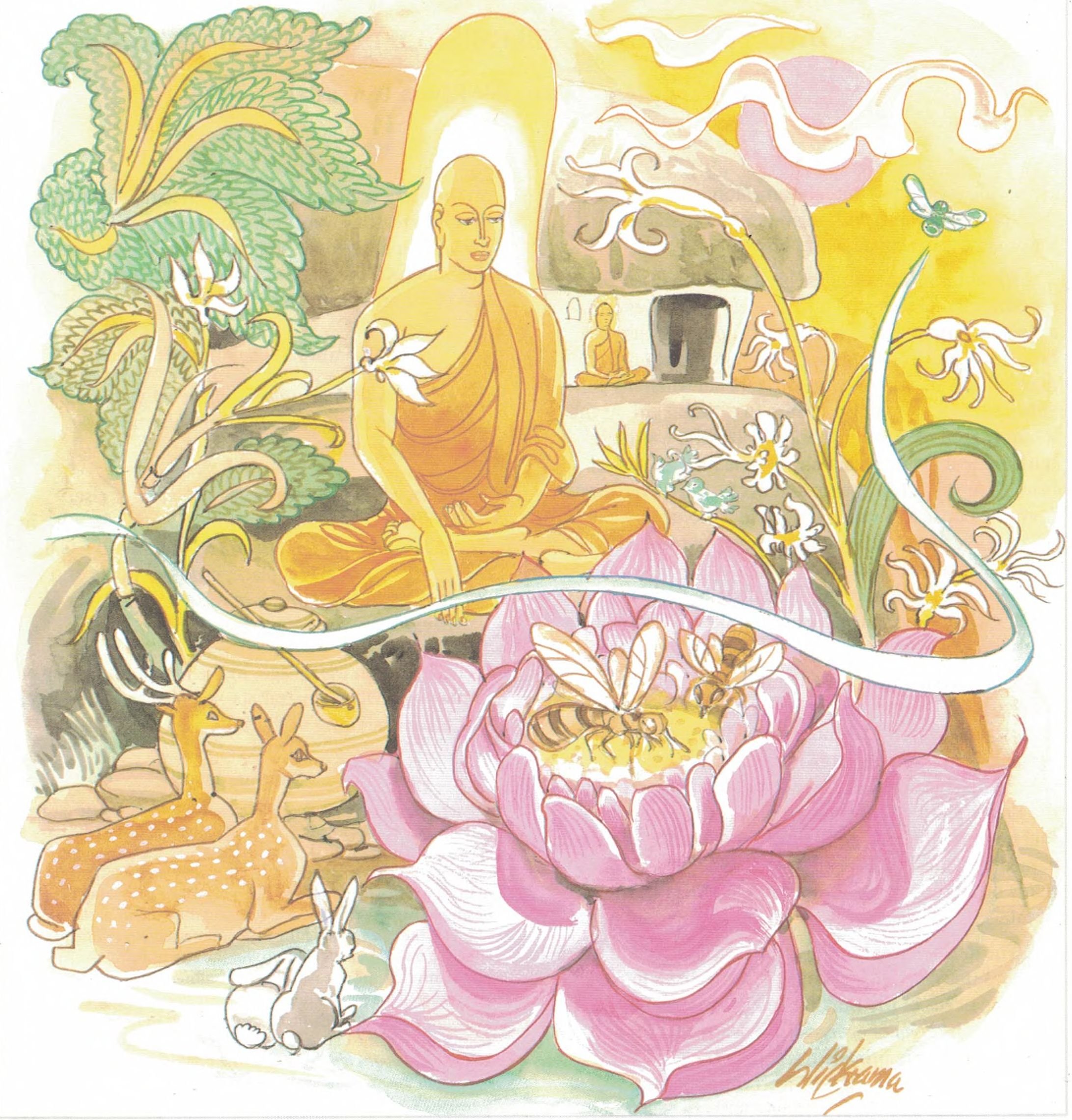Dhammapada (Illustrated)
by Ven. Weagoda Sarada Maha Thero | 1993 | 341,201 words | ISBN-10: 9810049382 | ISBN-13: 9789810049386
This page describes The Story of a Woman which is verse 99 of the English translation of the Dhammapada which forms a part of the Sutta Pitaka of the Buddhist canon of literature. Presenting the fundamental basics of the Buddhist way of life, the Dhammapada is a collection of 423 stanzas. This verse 99 is part of the Arahanta Vagga (The Saints) and the moral of the story is “Forests where no commoners delight, are a delight to those who seek no sensual pleasures”.
Verse 99 - The Story of a Woman
Pali text, illustration and English translation of Dhammapada verse 99:
ramaṇīyāni araññāni yattha na ramatī jano |
vītarāgā ramissanti na te kāmagavesino || 99 ||
99. Delightful are the forests where folk do not delight, there the Passionless delight, they’re not pleasure-seekers.
 Forests where no commoners delight, are a delight to those who seek no sensual pleasures. |
The Story of a Woman
While residing at the Jetavana Monastery, the Buddha spoke this verse, with reference to a woman of doubtful character. We are told that a certain monk who lived by his alms-bowl, got a meditation topic from the Buddha and retired to a dilapidated pleasure garden for the purpose of meditation. Now a certain courtesan made an appointment with a man, saying, “I will go to such and such a place and you meet me there.” The woman kept the appointment, but the man did not. For some time she watched in vain the path by which she expected him to come. Finally, disappointed at his failure to keep his appointment, she strolled hither and thither and went into the pleasure garden. There she saw the monk sitting cross-legged. Looking this way and that, and seeing no one else about, she said to herself, “Here is a man; I will throw his thoughts into confusion.” So standing in front of the monk, she took down her undergarment several times and put it on again, unloosened her hair and bound it up again, and clapped her hands and laughed. The Venerable became excited; his whole body, in fact, was suffused with excitement. “What does this mean?” thought he.
The Buddha considered within himself, “A monk obtained a meditation topic from me and went forth to perform his meditations. How is he getting on?” Seeing that woman, and observing her evil conduct, and perceiving that her evil conduct was upsetting the Venerable, still remaining seated in his perfumed chamber he spoke as follows, “Monks, there is no delight where those abide who seek after their lusts. But where those abide who are free from passion, that place is full of delight.” So saying, he sent forth a radiant image of himself, and instructing the Venerable in the Dhamma, recited this stanza.
Explanatory Translation (Verse 99)
yattha jano na ramatī ramaṇīyāni araññāni
vītarāgā ramissanti te kāmagavesino na
yattha: those places; jano: the worldly masses; na ramatī: do not take delight in; ramaṇīyāni araññāni: (such) attractive forests; vītarāgā: the passionless; ramissanti: take delight in; te: those places; kāmagavesino [kāmagavesina]: pursuers of sensual pleasures; na: do not take delight in
Those fascinating forests that do not capture the mind of the worldly masses and in which they do not take delight are attractive to the passionless ones. The Arahats take delight in the forests, because they are not pursuers of sensual pleasures.
Commentary and exegetical material (Verse 99)
vitarāgo: the passionless one: the arahat. The arahat is essentially a passionless one. An arahat, literally, a worthy one, is not subject to rebirth because he does not accumulate fresh Kammic activities. The seeds of his reproduction have all been destroyed. The arahat realizes that what was to be accomplished has been done, a heavy burden of sorrow has finally been relinquished, and all forms of craving and all shades of ignorance are totally annihilated. The happy pilgrim now stands on heights more than celestial, far removed from uncontrolled passions and the defilements of the world, experiencing the unutterable bliss of Nibbāna. Rebirth can no longer affect him since no more reproductive seeds are formed by fresh kammic activities. An arahat is called an asekha, one who does not undergo training, as who has lived the holy life and has accomplished his object. The other saints from the sotāpatti stage to the arahat path stage are called sekhas because they still undergo training. Arahats could experience the Nibbānic bliss uninterruptedly for as long as they liked even in this life. This, in Pāli, is known as nirodha-samāpatti.
